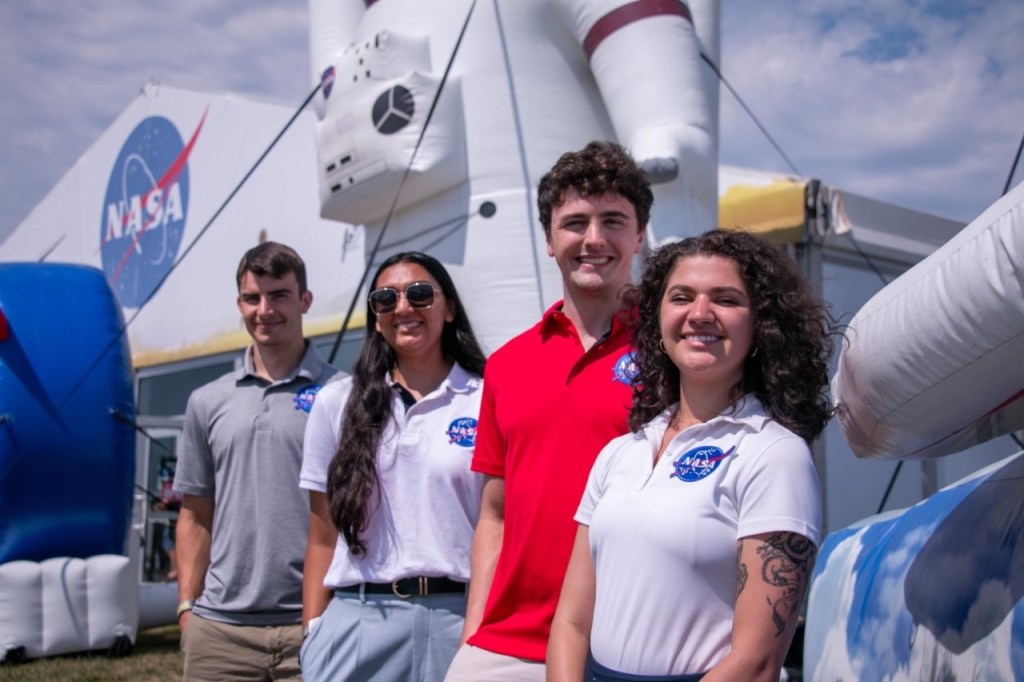Two members of the X-43 flight research project team from NASA’s Dryden Flight Research Center were on hand Tuesday evening, April 5, when the X-43 / Hyper-X project team and several of its major players were honored by Aviation Week and Space Technology during the publication’s 48th annual Laurel Awards program at the National Air and Space Museum in Washington, D.C.
Laurel honorees were nominated by the editors of the aerospace magazine for “extraordinary individual and team accomplishments in the global aviation, aerospace and defense industries.”
The Laureates Hall of Fame Award in Aeronautics/Propulsion went to Hyper-X program manager Vincent Rausch and supersonic-combustion ramjet engine developer Randall Voland, both of NASA’s Langley Research Center, Hampton, Va. The award also cited ATK GASL President Anthony Castrogiovanni, Tullahoma, Tenn., and the entire X-43 Hyper-X scramjet team “for their completion of the first two free flights of an operating scramjet engine integrated with a representative hypersonic airframe.”
The two flights from NASA Dryden at Edwards Air Force Base in March and November 2004 set world speed records for aircraft powered by a non-rocket, air-breathing engine, the first near Mach 7 (seven times the speed of sound) and the second at almost Mach 10.
Dryden aerodynamics engineer Laurie Marshall Grindle and controls engineer Catherine Bahm, who served as chief engineer and deputy chief engineer respectively for the final X-43A flight, represented the NASA Dryden X-43 project team at the awards presentation.
Another of NASA’s aeronautics efforts, the Synthetic Vision Systems (SVS) project, was one of five teams honored in the Information Technology/Electronics category. The project was recognized as “a government-industry-university research team, for bringing SVS and enhanced-vision avionics to an impressive level of functionality, significantly improving aircraft safety during reduced visibility flight conditions.”
“We are elated to see the hard work and extraordinary achievement of our NASA Aeronautics teams and individuals honored in this way. The X-43A team’s accomplishments speak to exciting breakthroughs in aviation in the future, and the Synthetic Vision project touches the public right now with increased flight safety,” said Dr. J. Victor Lebacqz, NASA’s Associate Administrator for Aeronautics Research.
The Laureates Hall of Fame Award in the space category went to a collaborative team that includes NASA’s Jet Propulsion Laboratory (JPL), Pasadena, Calif.; Cornell University, Cornell, N.Y.; the aerospace industry; and the Mars Exploration Rover mission team “for its remarkable year investigating the Martian surface with Spirit and Opportunity.”
Also recognized in the space category were the International Space Station’s Expedition 9 crew, astronaut Mike Fincke and cosmonaut Gennady Padalka, as well as the U.S. and Russian ground teams. They were cited for completing several never-before-accomplished tasks during their six-month mission on the Station in 2004.
Dr. Charles Elachi, Director of JPL, was recognized for his leadership of the Mars Exploration Rover program and the Cassini mission team. Those teams are searching for signs of life on Mars and unveiling the mysteries of Saturn’s moon Titan, respectively.
The JPL and the Lockheed Martin Stardust team were honored for designing and guiding the Stardust spacecraft to within 140 miles of the nucleus of the comet Wild 2. Stardust, scheduled to return to Earth early in 2006, has collected the first comet dust.
The magazine also recognized the accomplishments of NASA’s Cassini spacecraft engineers and scientists. Following Cassini’s long journey to Saturn, the mission team carried out the highly successful June 30 orbit insertion and gathered close-up data.
Several historic NASA figures were also honored with 2004 Laurel Legend awards. They included Max Faget, the late famed NASA spacecraft engineer. Also recognized were America’s first women astronauts – Sally Ride, Kathy Sullivan, Rhea Seddon, Anna Fisher, Shannon Lucid, and the late Judith Resnik. Legend awards are given to previous Laurel winners or individuals chosen for contributions to the global field of aerospace over a period of years.
– end –
text-only version of this release
To receive status reports and news releases issued from the Dryden Newsroom electronically, send a blank e-mail message to dfrc-subscribe@newsletters.nasa.gov. To unsubscribe, send a blank e-mail message to dfrc-unsubscribe@newsletters.nasa.gov. The system will confirm your request via e-mail.
Dryden Flight Research Center
P.O. Box 273
Edwards, California 93523
Phone 661/276-3449
FAX 661/276-3566
Alan Brown
NASA Dryden Flight Research Center
Phone: 661/276-2665
David E. Steitz/Doc Mirelson
NASA Headquarters, Washington, DC
Phone: 202/358-1600
























